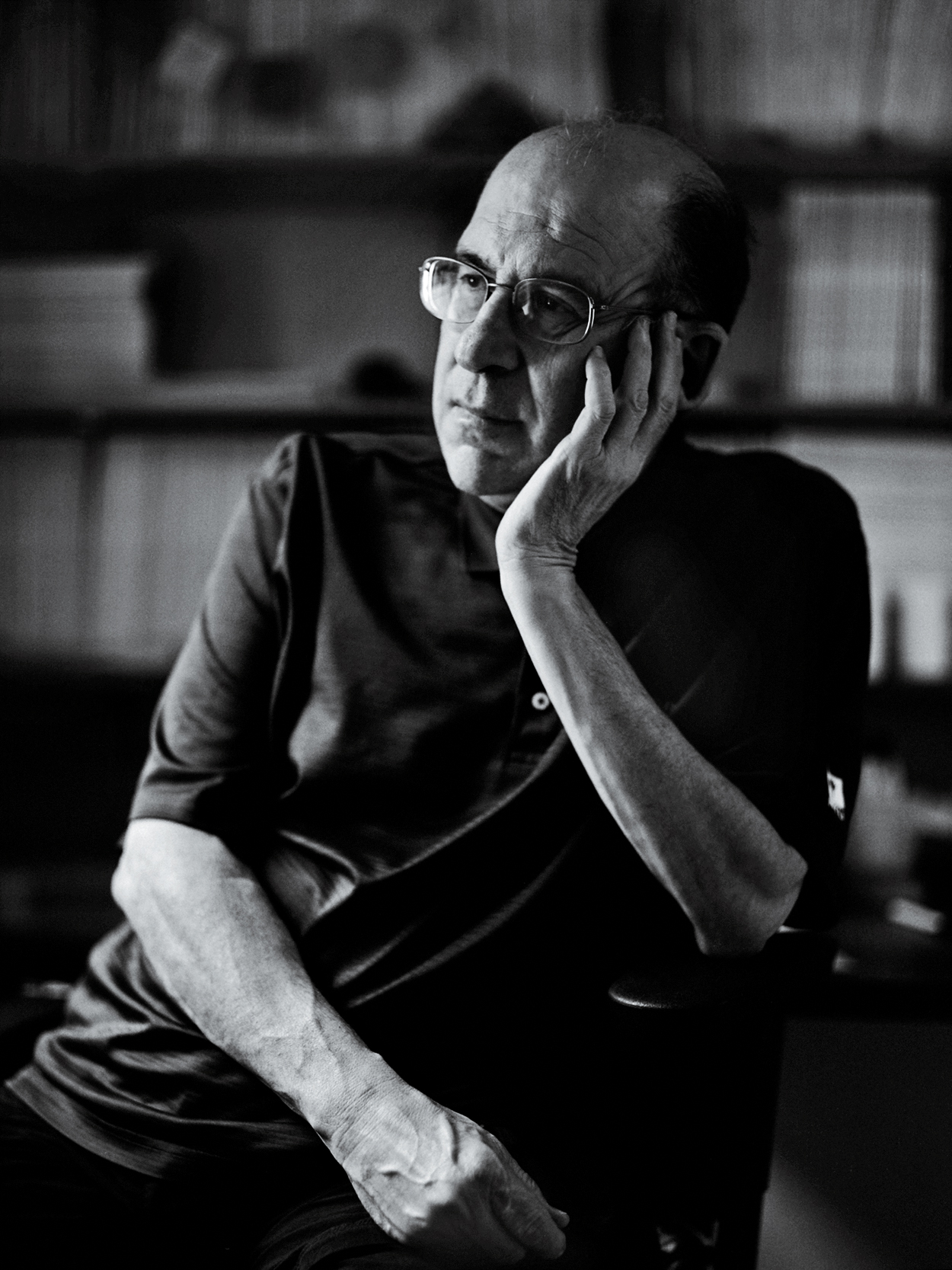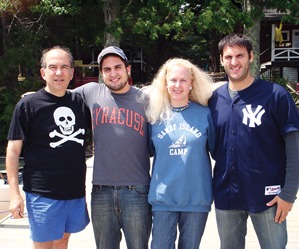Puzzle Corner’s Keeper

Allan Gottlieb ’67, a pioneer in parallel computing, has worked at New York University for 35 years. He has been married to his wife, Alice Bendix Gottlieb, for 43 years. But he has been editing the Puzzle Corner column for 50 years. “I don’t know of any puzzle columnist—or any columnist on any topic—with greater longevity,” says Gottlieb, 70. And for that half-century, alumni have eagerly drawn on spatial reasoning, number theory, logic, and probability to tackle challenges about wizards, sailboats, desert islands, and more.
When Gottlieb started the column, as an undergraduate at MIT, he wrote all of the problems and most of the solutions himself in his dorm room. Now he acts mainly as an editor, choosing puzzles and solutions from the community that has grown up around the project. He typically receives around 50 solutions per issue, largely from MIT alumni. “My friends and I all send e-mails around comparing our solutions,” says Sam Ribnick ’05, an education consultant. The column offers what he calls “a dose of legitimately challenging puzzles.”

Gottlieb, who grew up on Long Island, didn’t initially plan to attend MIT when he was accepted as a high school senior. Neither of his parents had gone to college. His father, who owned a furniture store in Queens, passed away during the admissions process, making the prospect of paying private university tuition daunting. But a fellowship from Grumman, a Long Island–based aerospace company, allowed him to enroll. A math major, he started the puzzle column in early 1966, during his junior year. “Hi,” he began the first one. “My name is Allan Gottlieb and I reside at Baker House, room 632 … Being a basically lazy individual, I would prefer to be deluged with puzzle suggestions. If necessary, however, I have a supply of my own.” Initially the column ran in Tech Engineering News, a now-defunct student publication. Later that year it also found a home in this magazine, where it has appeared regularly ever since. “I don’t have a good answer for why I started it or why it’s continued all these years,” he says. But eventually it took on a life of its own. Now, he says, “it’s just one of my jobs.”
Gottlieb’s primary jobs have been research and teaching. He earned a PhD in mathematics from Brandeis, writing his thesis on dynamical systems. (In a dynamical system, the behavior of a point in a geometrical system evolves over time according to fixed rules, often in the form of differential equations.) “It was a horrible time to be looking for academic work,” he recalls, but in 1972, just a few months before he’d even defended his thesis, he found a position at North Adams State College in Massachusetts, teaching math and computer programming. Gottlieb had taken a couple of computer classes at MIT, but he gained much of his expertise at Grumman, where he’d worked every summer, mainly in the digital computing department. (He became so expert on a new programming language there that he ended up giving lectures to the company’s scientists.) Thanks to this experience, “I knew something about computing, and not many people did back then,” he says.

In 1973 he moved to York College, part of the City University of New York, when Alice, whom he’d married the previous year, was beginning a PhD program in immunology at Rockefeller University. After six years, he earned tenure at York and took a sabbatical at New York University to learn graph theory. But “I didn’t learn any graph theory,” he recalls. Instead, he was recruited to work on a project in parallel computing, which became the NYU Ultracomputer. A prototype of the first Ultracomputer still hangs on the wall in the NYU computer science department: roughly the size of three Scrabble boxes, it has four processors, four memory modules, and four custom-made switches. “This was our pride and joy,” says Gottlieb, who eventually earned tenure at NYU and led the project.
Over the years, Gottlieb’s primary focus gradually shifted from the lab to the classroom; since 2005, he has concentrated on teaching, posting detailed lecture notes online and meeting extensively with students. In class, he conveys an earnest enthusiasm as he delves into the rudiments of Java: “I wish I could write a few words or pages or books that would show you how to avoid making errors,” he tells the undergraduates. But “it will be a semester-long (actually lifelong) effort. We will write programs in class, which will doubtless have errors that we can fix together.”
Though occasionally students see puzzles on Gottlieb’s computer when they stop by for office hours, Puzzle Corner remains a separate endeavor—and inspires its own devoted following. Each time Gottlieb receives a batch of solutions, he says, he recognizes about half the names, although he has met almost none of the responders in person. Avi Ornstein ’71, who missed overlapping with Gottlieb at Baker House by a matter of months and now teaches science and math at a magnet school in Hartford, Connecticut, has been creating puzzles since the age of 15. He says that he can usually get an answer to at least one problem in each issue. “Some have been easy and I can solve them in one or two hours,” he says, but others take “several days” of concentrated effort. Ken Rosato ’73, a retired land surveyor who lives near Houston, says that when he first started reading Puzzle Corner, he liked to work on a puzzle “every now and then.” But over time, he “got more obsessive, trying to do one from every issue.” Today, he serves as an advance reader for the column, although he’s still never met Gottlieb.


In July 1990, Gottlieb announced the end of Puzzle Corner’s 23-year run in Technology Review. Pressured to expand coverage of MIT and alumni news, the editors were canceling the column. But alumni wouldn’t have it. They wrote letters in droves. Doing the puzzles reminded them of all-night sessions in the Student Center coffee shop with pages of false starts on a tough problem set. It helped them keep their math and logical faculties in good working order. “MIT is a one-of-a-kind institution,” wrote Steven Feldman ’79. “So is the Puzzle Corner.” The editors got the message, and more than 25 years later, the column remains a fixture in the magazine.
Today, Gottlieb has a hard time identifying a favorite puzzle from over the years. But he has a clear sense of what characterizes the successful ones. In general, they are not too theoretical, he says. They involve real objects or numbers. They have singular solutions and don’t require mathematical proofs. The most impressive solution to appear in the column, however, involved 29 equations and 30 variables that R. Robinson Rowe, Class of 1918, calculated by hand in 1971. “Being retired, I had lots of time,” Rowe wrote. “But were I not retired, I would have programmed the job for a one-minute task on an IBM.”
For Gottlieb, some of his old columns read like a diary in shorthand. In 1976, he dedicated a column to his wife, who is now the chair of the dermatology department at Tufts University School of Medicine. In 1982 and early 1986, he wrote about the births of their two sons, David ’04, MEng ’04, and Michael, respectively. He wrote of pleading and shouting to get a teenage David to turn down the volume on his electric guitar, and later of the bittersweet feeling of dropping him off as a freshman at MIT. He used the introduction to a 2013 column to announce the birth of his grandson, Hunter.
“I’m more widely known for Puzzle Corner by far than for any serious work I ever did in mathematics or computer science,” says Gottlieb. And his wife’s distinguished career notwithstanding, “when people find out she’s the Alice in the column, they are very impressed.”
As for the column’s future, Gottlieb says he has no immediate plans to retire. The current issue includes the first one of its 51st year. “And I can’t imagine not writing the next one, or the one after that,” he says. “At some point I’ll have to stop, but so far, so good.”
Keep Reading
Most Popular
Large language models can do jaw-dropping things. But nobody knows exactly why.
And that's a problem. Figuring it out is one of the biggest scientific puzzles of our time and a crucial step towards controlling more powerful future models.
The problem with plug-in hybrids? Their drivers.
Plug-in hybrids are often sold as a transition to EVs, but new data from Europe shows we’re still underestimating the emissions they produce.
Google DeepMind’s new generative model makes Super Mario–like games from scratch
Genie learns how to control games by watching hours and hours of video. It could help train next-gen robots too.
How scientists traced a mysterious covid case back to six toilets
When wastewater surveillance turns into a hunt for a single infected individual, the ethics get tricky.
Stay connected
Get the latest updates from
MIT Technology Review
Discover special offers, top stories, upcoming events, and more.